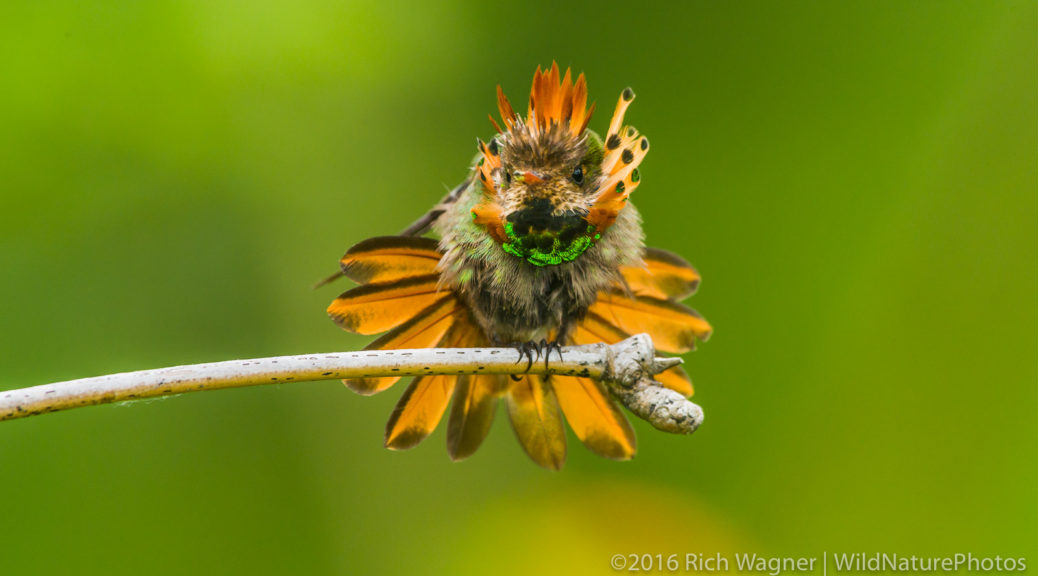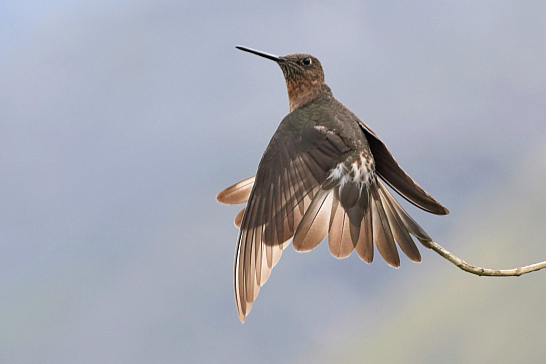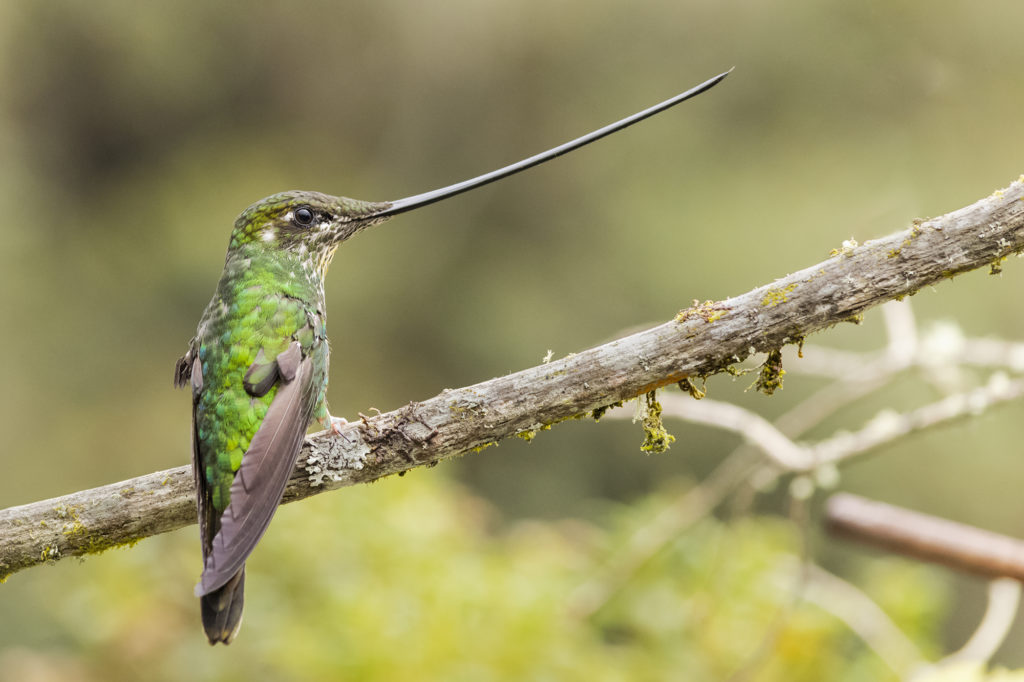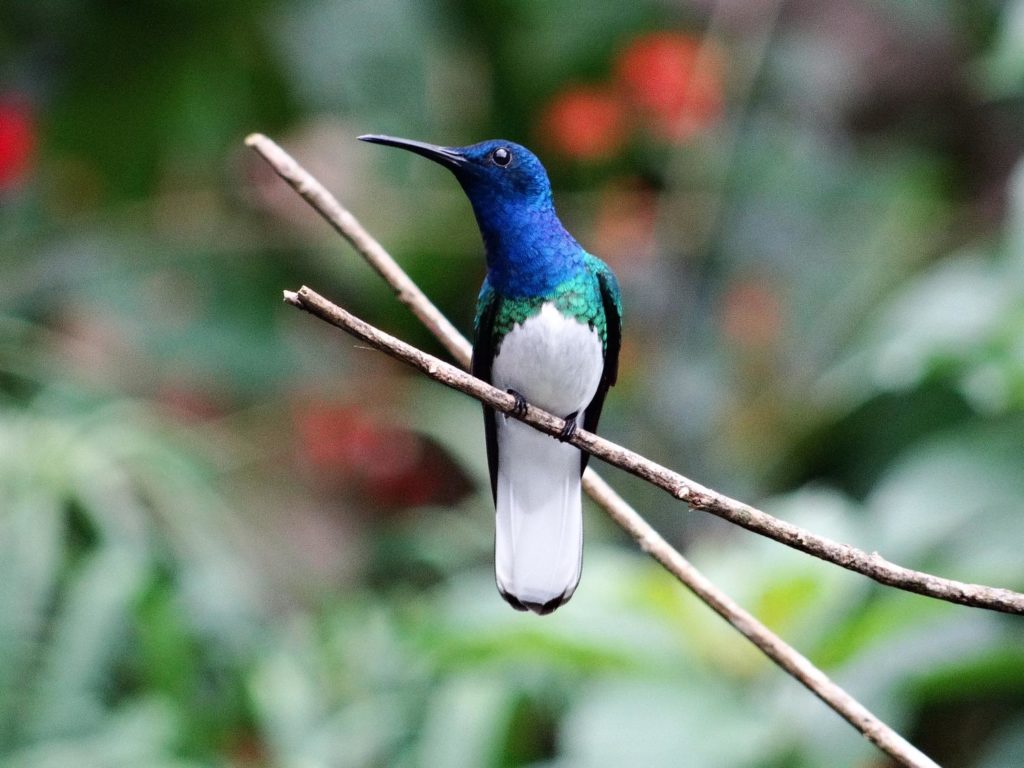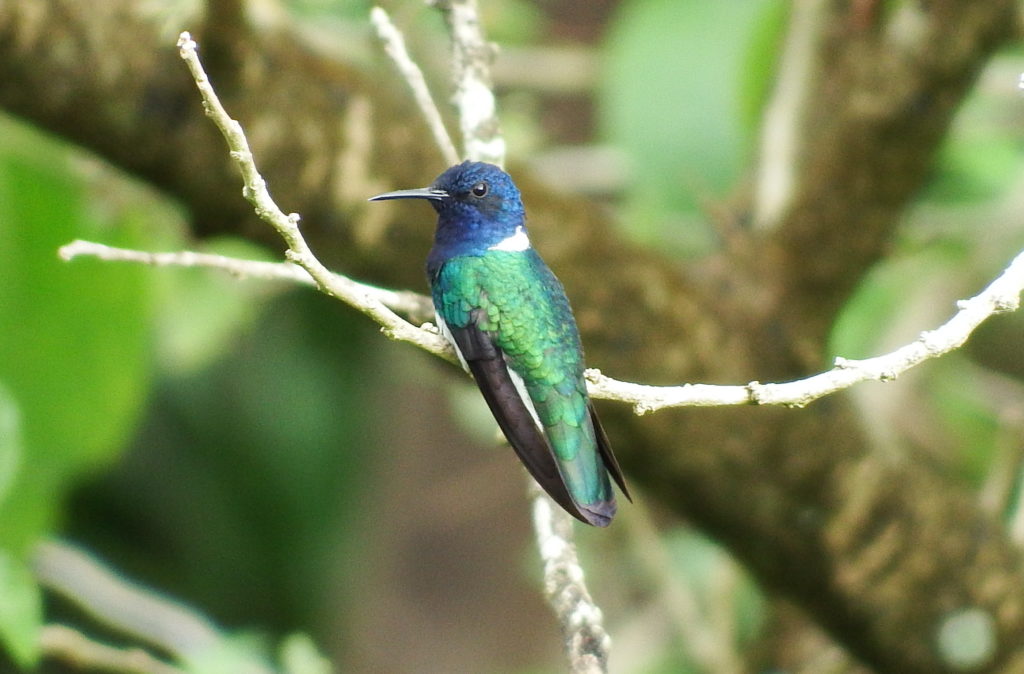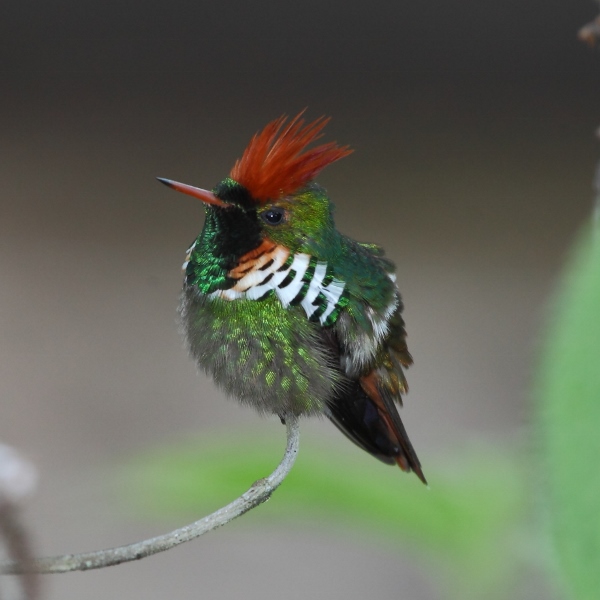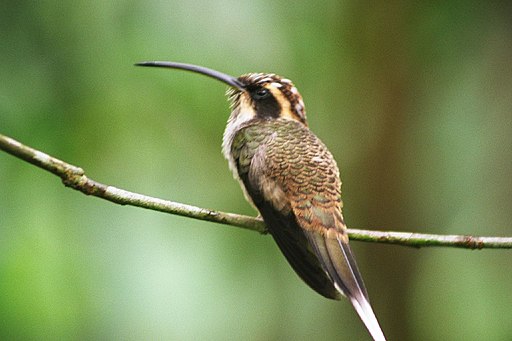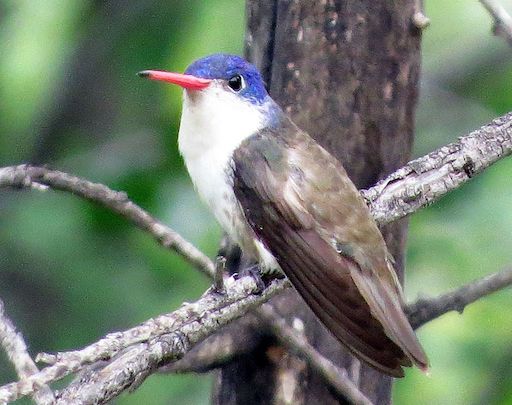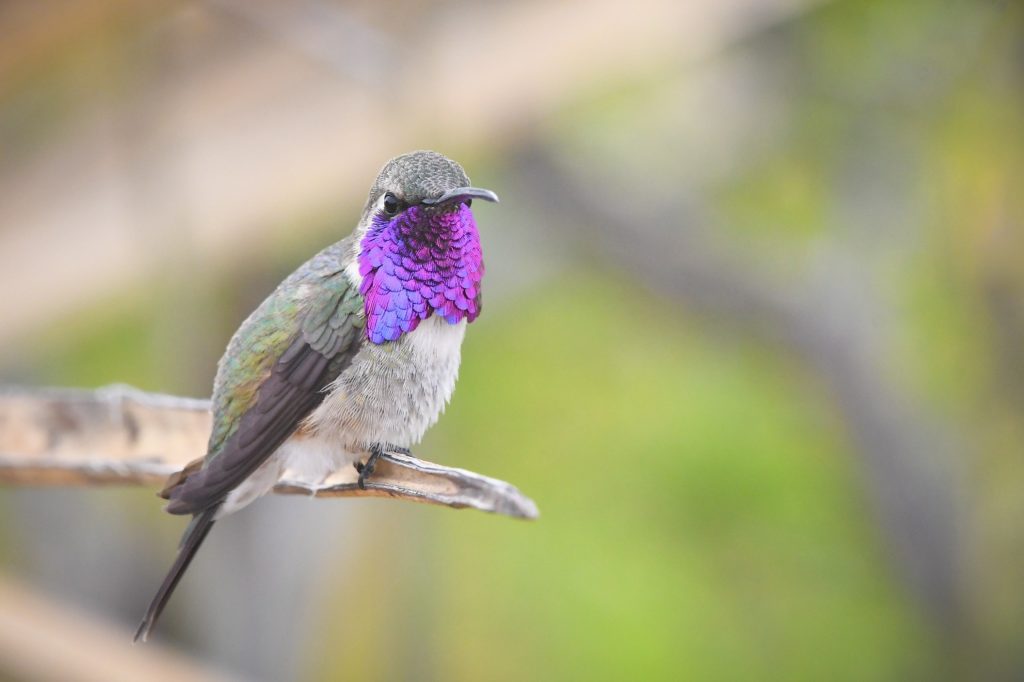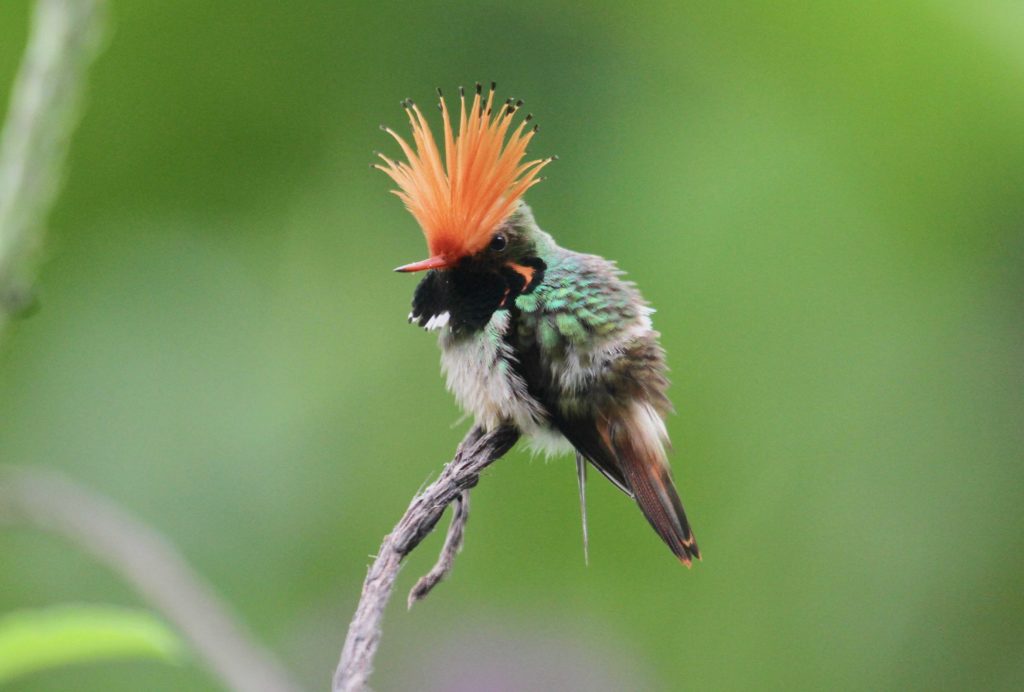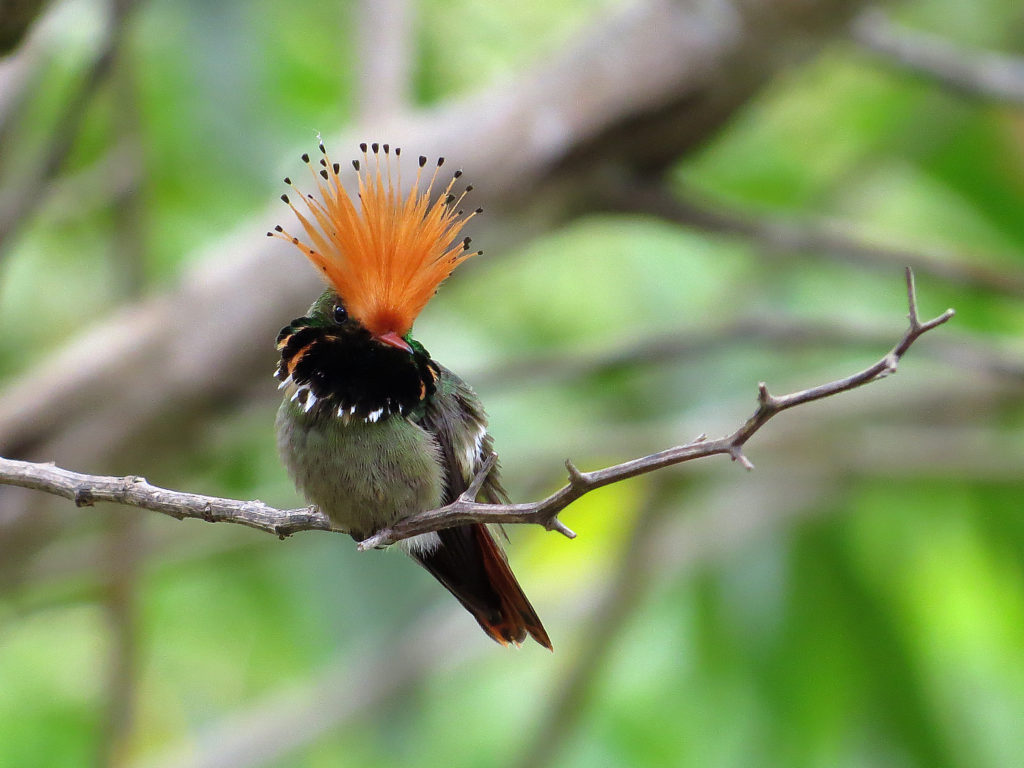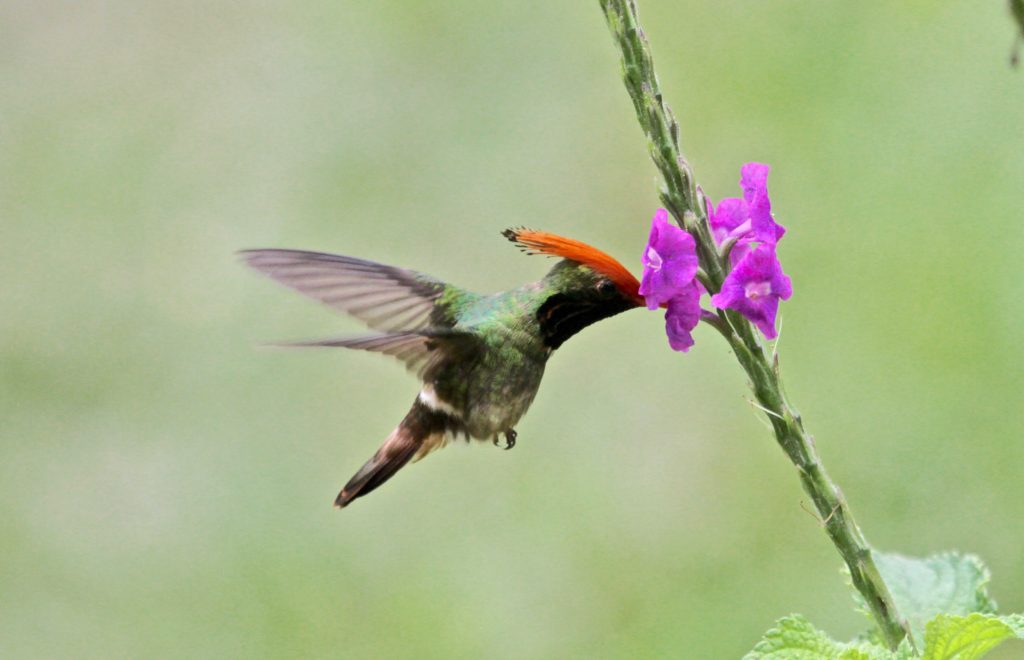There are so many interesting facts about hummingbirds that, compounded into their tiny flying forms, hummingbirds inspire poetic descriptions like this one from John James Audubon himself, who called them “the greatest ornaments of the gardens and forests. Such in most cases is the brilliancy of their plumage, that I am unable to find apt objects of comparison unless I resort to the most brilliant gems and the richest metals.”
Facts about Hummingbirds: Size is Relative
Their diminutive size is probably the most obvious trait shared among the 330+ species of the family Trochilidae, whose most close relative is the swifts. Tiny Bee Hummingbird is the smallest, less than two ounces and found only in Cuba. The largest, the Giant Hummingbird, can weigh up to 12 times as much, and is found in the Andes, along with the Sword-billed Hummingbird, whose own size claim to fame is being the only bird with a bill longer than its body. Both can be found on our Northern Peru and Peru: Cusco to Mánu National Park tours:
- Northern Peru Endemics July 12 – 23, $3990, from Lima
- Peru: Cusco to Mánu National Park October 17 – 31, $5490, from Lima
Home is the Western Hemisphere
Hummingbirds are a favorite of most birders, but they are particularly enthralling to our guests from Europe and Asia, who must travel to the Western Hemisphere to see them. Africa’s sunbirds, nectar-loving birds adapted to local flora, are often described as the hummingbirds of the Eastern Hemisphere.
Other location-based facts about hummingbirds:
- US birders enjoy 17 nesting species of hummingbird
- Half of all hummingbird species are concentrated in a belt near the equator
Some hummingbirds are wide-ranging, like the White-necked Jacobin, though you do have to leave the US to see it. We often see this species on our Belize tours, two upcoming. The October trip is one day longer, but you can see the value in traveling in the “green season” by comparison.
- Belize Green Season July 16 – 23, $2990, from Belize City
- Belize Birding and Nature October 2 – 10, $4290, from Belize City
They may be seen on many of our Central America and northern South America tours.
Other hummingbirds are endemics, their ranges almost as diminutive as the birds themselves. The gorgeous Violet-capped Hummingbird is not widespread even inside Panama and a tiny sliver of Colombia contiguous with the Darién, a wilderness that flourishes between the two countries and benefits from a car-free break here in the Pan-American Highway.
We have chances to see Violet-capped on our upcoming tour to the Darién:
Panama and the Wild Darién July 29 – August 5, $2990, from Panama City
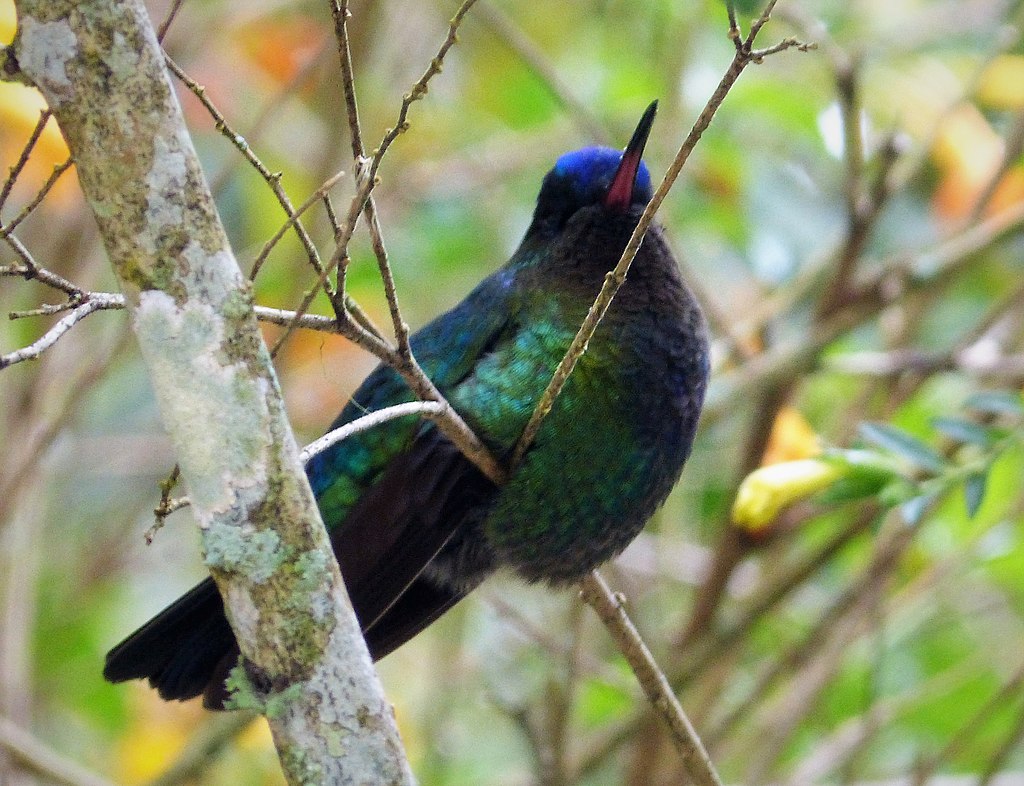
Picking up on Audubon’s description of hummingbirds, the Gilded Hummingbird and Glitter-throated Emerald call to mind “the most brilliant gems and the richest metals.” Both can be seen on our Brazil’s Pantanal tours:
- Brazil’s Pantanal: Jaguars! And More August 2 – 12, $5840, from Sao Paulo
- Brazil’s Pantanal: Jaguars! And More October 11 – 21, $5840, from Sao Paulo

Brazil Extensions Hummingbirds
To get a richer selection of hummingbirds, it’s advisable to choose the pre- and post-tour extensions, where our 2019 guests also saw Black Jacobin, Scale-throated Hermit, Black-eared Fairy, Frilled Coquette, Brazilian Ruby, Violet-capped Woodnymph, White-throated, and Versicoloured Emerald!
Hummingbirds in the US: Arizona and Texas
As we noted above, 17 hummingbirds regularly nest in the US, as far north as Alaska, where birders delight in the Rufous Hummingbird, possibly because there are no other hummingbirds to chase off the feeders! (Elsewhere, birders and other hummingbirds might find them more aggressive than adorable.) Our US tours to Texas and Arizona turn up the highest variety of hummingbirds, and we make sure to see as many as we can!
We have three Monsoon Madness tours upcoming in Arizona, host to the highest diversity of hummingbirds of any US state. On our August 2021 tour, we saw a full dozen hummingbirds, including two our guests selected as the co-birds of the trip, the Violet-crowned and the Lucifer.
Arizona Monsoon Madness, all $2,790, from Tucson:
- Arizona Monsoon Madness July 30 – August 6
- Arizona Monsoon Madness August 6 – 13
- Arizona Monsoon Madness August 13 – 20
The Lucifer Hummingbird is also found on our Texas tours, including the upcoming and popular South Texas: Fall Migration October 9 – 16, $2,390 from McAllen, TX.
A Rainbow of Hummingbirds
Rainbows are a great analogy for talking about the colors of hummingbirds, because tricky light refraction across their feathers is the reason that hummingbirds can look dull one moment and catch fire the next. Consider these two photos of the aforementioned adorable/aggressive Rufous Hummingbird:
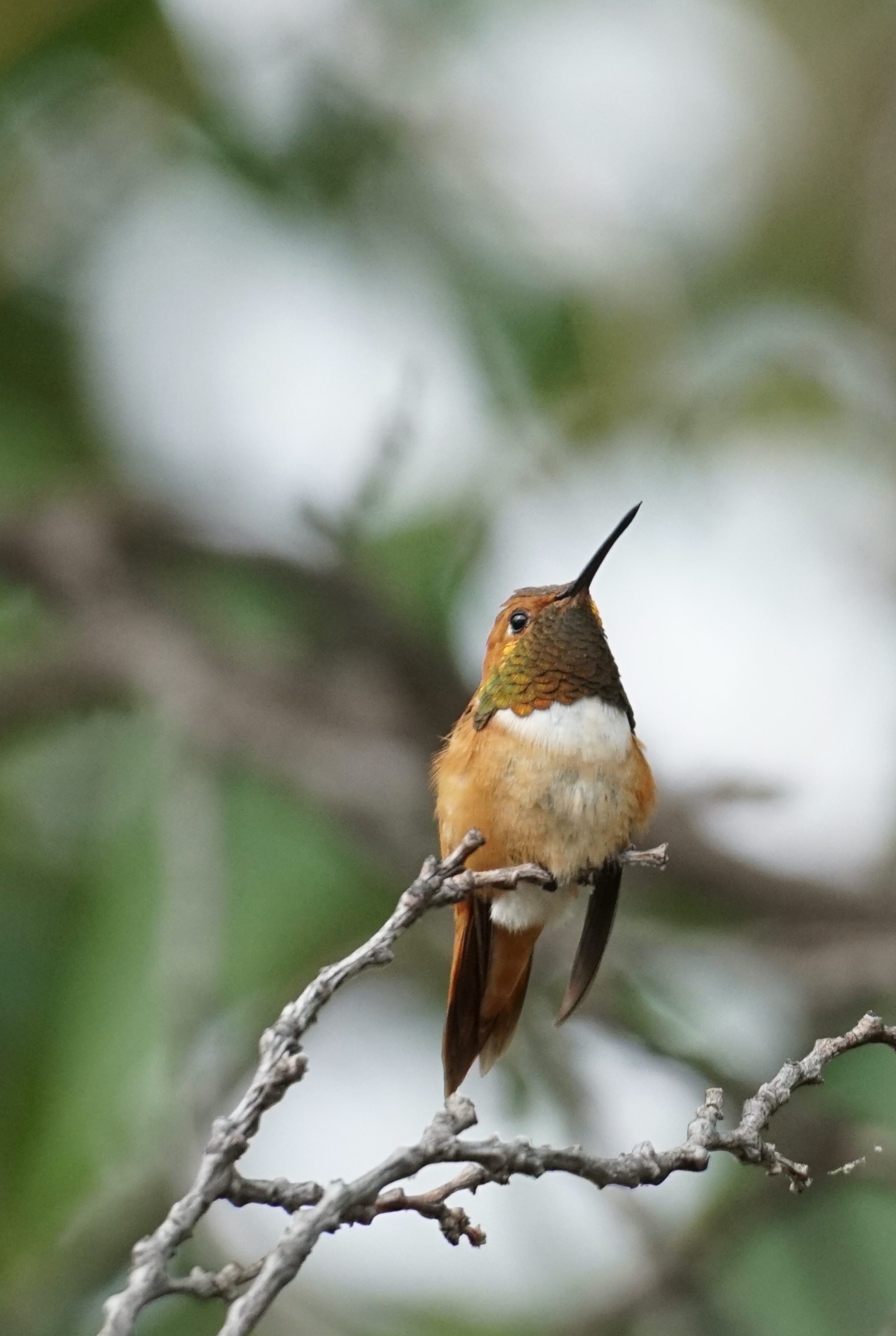

Their irridescence comes not from pigmentation but from light-shifting structures called melanosomes. Though other birds have them, including some ducks, the shape of hummingbirds’ melanosomes is unique, as Audubon describes in greater detail in “Hummingbirds Owe Their Shimmer to Microscopic Pancake-Like Structures.”
Though many hummingbirds flash at the gorget, the show-stopping Crimson Topaz takes an all-over approach to its irridescence.

Crimson Topaz is a Guianan Shield regional endemic that we have chances to see on our upcoming Guyana: Unspoiled Wilderness October 13 – 25. We also have chances in Guyana to see Tufted Coquette, which is one of the features of our trips to Trinidad and Tobago, a popular independent birding venture destination, where it must compete with Scarlet Ibis for bird of the trip!
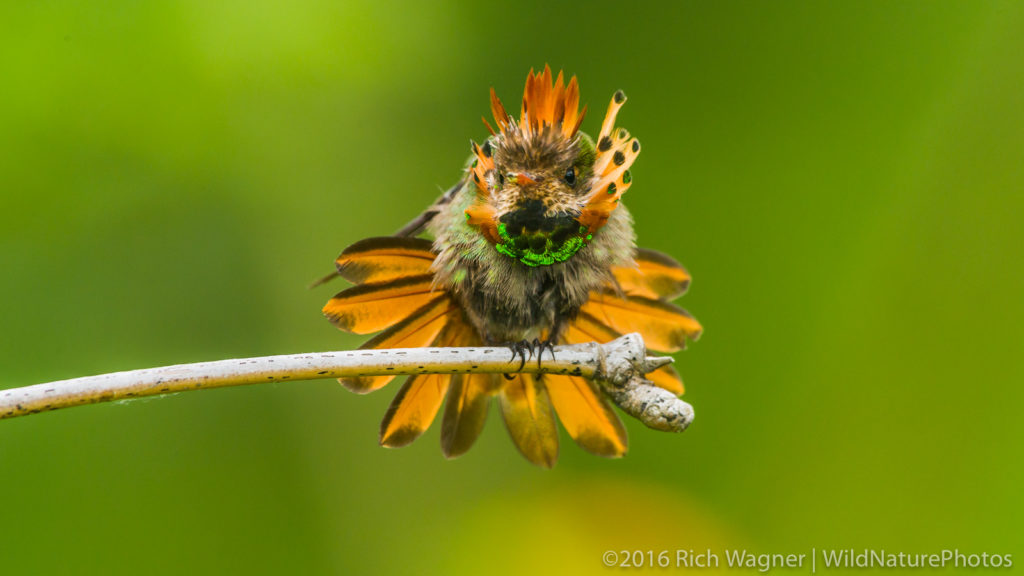
Flouncing Feathers
Perhaps the flirtiest of all the coquettes, however, is the Rufous-crested Coquette, an unforgettable species, which we have chances to see on two of our Panama trips:
- Panama: Introduction to Biodiversity October 1 – 9 and
- Western Panama: Tranquilo Bay October 15 – 22
Max Hummingbirds? Peru
Our Northern Peru guests also saw Rufous-crested Coquette in 2019, along with 50 other hummingbirds! That’s right, 51 species of hummingbird, listed here on the 2019 Northern Peru trip report. Our Peru: Cusco to Mánu National Park guests found 30 hummingbirds, though Rufous-crested Coquette was not among them.
Snowcap Hummingbird also has a beautiful noggin, though far less adorned than the Rufous-crested. We often see this beauty on our Costa Rica: Carribean Side tour, which is Oct. 13-23 this year.
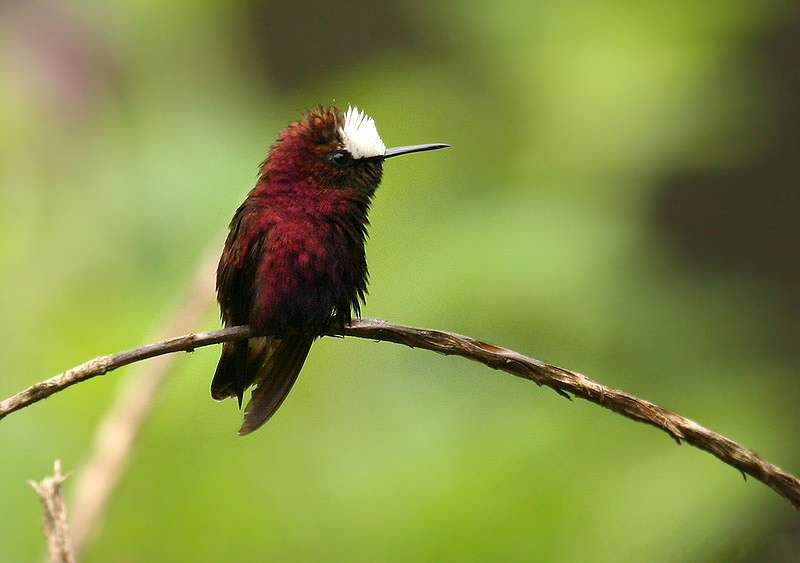
Sounds Beyond Humming!
Our short ‘facts about hummingbirds’ blog wouldn’t be complete without touching on these birds’ namesake characteristic.
As anyone who has spent anytime sitting near an over-subscribed feeder will notice, the humming of hummingbirds is much more varied than the same word used to describe the monotone of a plugged-in refrigerator. Some of their humming comes from rapid wingbeats, ranging from a dozen wingbeats per second for Giant Hummingbird to 80 per second by the record-holding Amethyst Woodstar, which we have chances to see in Peru and Brazil.
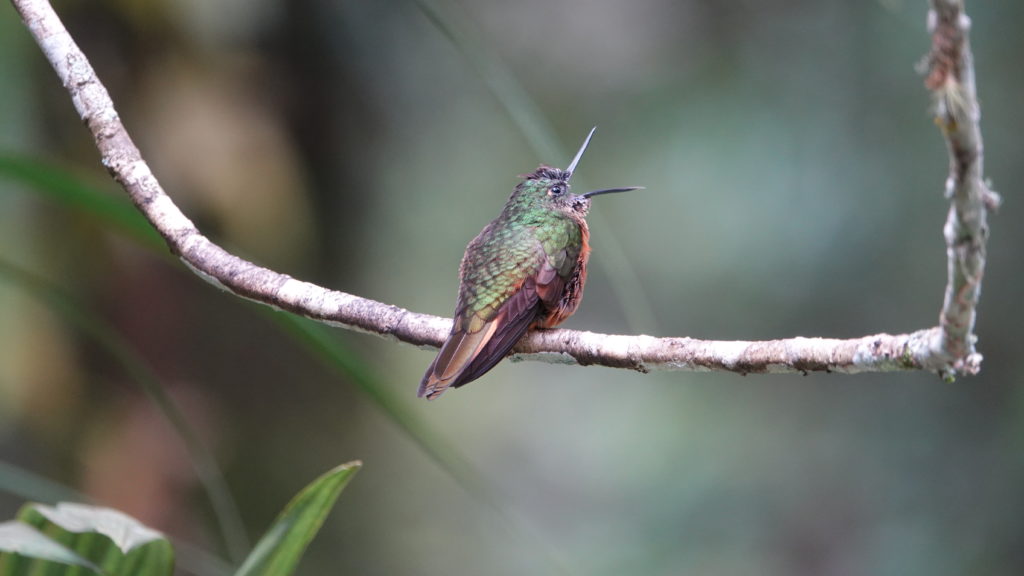
But hummingbirds also make other noises, including signature sounds made with their tail feathers, and territorial ‘chip’ calls. A few of them even sing!
The Broad-tailed Hummingbird, which we are almost certain to see on our three Arizona Monsoon Madness tours, makes a distinctive metallic sound in flight, which you can hear on this All About Birds page by clicking the audio file labeled ‘display.’
Where there are more species in competition, birds are more likely to have more complex vocalizations. The Mexican Violetear (formerly known as the Green Violetear, split into Mexican and Lesser Violetear in 2016) is one of those hummingbirds on the chatty side. We have great chances to see (and often first hear) Mexican Violetear on our two upcoming Oaxaca: Birds, Culture and Crafts tours. One of the things guests love about this trip is it includes beach time/time on the coast.
- Oaxaca: Birds, Culture and Crafts August 1 – 9 (9-day, 8-night) $3790, from Oaxaca City
- Oaxaca: Birds Culture and Crafts October 17 – 28, (12-day, 11-night) $4490, from Oaxaca City
Guests saw 15 hummingbirds on that trip in 2021.

Adding to your Hummingbird Life List
If you are looking for specific hummingbirds, or want to know which hummingbirds may be seen on our tours, please check out the wealth of information available on our trip reports page! Though many of our tours feature a rich variety of hummingbirds, through our Independent Birding Ventures we design tours based on what you want to see. Do you want a trip that maximizes hummingbirds? Sign up for Northern Peru Endemics, or let us design a hummingbird-rich trip for your group!

